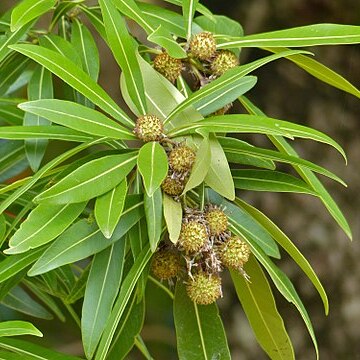Leaves in whorls of (2) 3–4; leaf blades 8–33 × 1.8–9 cm, lanceolate, subacute to slightly acuminate at the apex, narrowly cuneate at the base, glabrous, at first rather shiny on upper surface; petiole 0.8–2.5 cm long; stipule limbs ± triangular, bifid, circumscissile separating into a toothed ring.
Inflorescences solitary, the head 1.5–2.5 cm in diameter; peduncles 2–9.5 cm long, puberulous with very short hairs, with 2–4 bracts just above the middle; bracts membranous often connate and calyptra-like, 0.4–1 cm long, ovate; true bracteoles 2.8–5 mm long, filiform-spathulate.
Medium to large tree, (1.8-)3.0-1.0 m high. Leaves in whorls of 3 or 4, lanceolate, glabrous. Inflorescence solitary, dense, a globular head. Fruit a septicidal capsule. Flowers pinkish green or white or yellowish brown.
Corolla pinkish-green, white or yellowish-brown; tube 3–6.5 mm long, densely silky grey-pubescent outside; lobes often tinged mauve, 1–2.5 × 0.5–0.7 mm, linear, ± imbricate, pubescent outside.
A tree. It can grow 40 m tall. The trunk can be 150 cm across. The leaves are in rings of 3-5 near the ends of twigs. The leaves are 7-33 cm long by 2-9 cm wide.
Calyx tube 1–2 mm long; limb-tube c. 0.5 mm long, narrowly tubular; lobes 1–2.5(4.5) × 0.5–0.6 mm, oblong, linear or triangular, pubescent.
Foliis lineari-lanceolatis ternis enerviis. Nerium foliis ternatis, longe lanceolatis, planis nitidis, spithamalibus.
Medium to large tree (1.5)3–12 m tall; bark grey, fissured and scaly; branches glabrous; heart-wood white.
Fruit a septicidal capsule, the valves 3.5 mm long, shiny inside, pubescent outside.
Pollen presenter green, 0.5 mm long, ellipsoid or capitate.
Seeds 2.2–2.8 mm long, narrowly compressed, obovoid.
Style white, 0.9–1.45 cm long.


